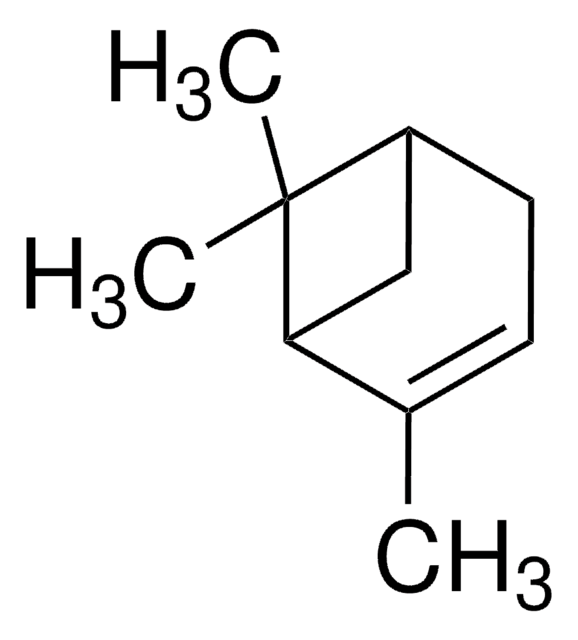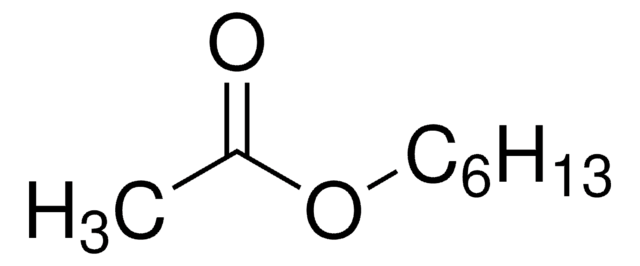112674
Isopentyl acetate
mixture of isomers, reagent grade, 98%
Sinônimo(s):
Acetic acid 3-methylbutyl ester, Isoamyl acetate
About This Item
Produtos recomendados
grau
reagent grade
Nível de qualidade
densidade de vapor
4.5 (vs air)
pressão de vapor
5 mmHg ( 25 °C)
Ensaio
98%
forma
liquid
temperatura de autoignição
680 °F
Lim. expl.
7.5 %
índice de refração
n20/D 1.4 (lit.)
pb
142 °C/756 mmHg (lit.)
pf
−78 °C (lit.)
densidade
0.876 g/mL at 25 °C (lit.)
cadeia de caracteres SMILES
CC(C)CCOC(C)=O
InChI
1S/C7H14O2/c1-6(2)4-5-9-7(3)8/h6H,4-5H2,1-3H3
chave InChI
MLFHJEHSLIIPHL-UHFFFAOYSA-N
Procurando produtos similares? Visita Guia de comparação de produtos
Descrição geral
Aplicação
- Development of a safety analysis method for volatile organic compounds using 2-phenoxyethanol as solvent.: This study developed a novel method for analyzing the safety of volatile organic compounds, including Isopentyl acetate, using 2-phenoxyethanol as a solvent. The method enhances the detection and quantification of these compounds in various matrices, which is crucial for ensuring safety standards in industrial applications (Wang et al., 2024).
- Addition of Saccharomyces eubayanus to SCOBY fermentations modulates the chemical and volatile compound profiles in kombucha.: This research demonstrated that introducing Saccharomyces eubayanus to kombucha fermentation alters its chemical and volatile profiles, including an increase in Isopentyl acetate, which impacts the beverage′s aroma and flavor profile (Venegas et al., 2023).
- Honey Bee Colonies (Apis mellifera L.) Perform Orientation Defensiveness That Varies among Bred Lines.: This article explored the behavioral responses of honey bee colonies to different volatile compounds, including Isopentyl acetate, finding variations in orientation defensiveness among different bred lines of bees (Akongte et al., 2023).
- Discovering Aethina tumida responses to attractant and repellent molecules: A potential basis for future management strategies.: The study investigated the responses of Aethina tumida (small hive beetle) to various attractant and repellent molecules, including Isopentyl acetate, which could inform future pest management strategies in apiculture (Roth et al., 2023).
- A Targeted and an Untargeted Metabolomics Approach to the Volatile Aroma Profile of Young ′Martina′ Wines.: This research utilized both targeted and untargeted metabolomics to analyze the aroma profile of young ′Martina′ wines, identifying Isopentyl acetate as a significant contributor to the wine′s volatile profile (Boban et al., 2022).
Palavra indicadora
Warning
Frases de perigo
Declarações de precaução
Classificações de perigo
Flam. Liq. 3
Perigos de suplementos
Código de classe de armazenamento
3 - Flammable liquids
Classe de risco de água (WGK)
WGK 1
Ponto de fulgor (°F)
91.4 °F - closed cup
Ponto de fulgor (°C)
33 °C - closed cup
Certificados de análise (COA)
Busque Certificados de análise (COA) digitando o Número do Lote do produto. Os números de lote e remessa podem ser encontrados no rótulo de um produto após a palavra “Lot” ou “Batch”.
Já possui este produto?
Encontre a documentação dos produtos que você adquiriu recentemente na biblioteca de documentos.
Nossa equipe de cientistas tem experiência em todas as áreas de pesquisa, incluindo Life Sciences, ciência de materiais, síntese química, cromatografia, química analítica e muitas outras.
Entre em contato com a assistência técnica





